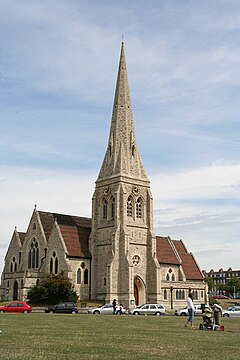Blackheath, London
| Blackheath | |
|---|---|
 All Saints' Church |
|
| Blackheath shown within Greater London | |
| Population | 26,914 (2011 Census. Lewisham Ward: 14,039) (2011 Census. Blackheath Westcombe Ward: 12,875) |
| OS grid reference | TQ395765 |
| • Charing Cross | 6.5 mi (10.5 km) WNW |
| London borough | |
| Ceremonial county | Greater London |
| Region | |
| Country | England |
| Sovereign state | United Kingdom |
| Post town | LONDON |
| Postcode district | SE3, SE13, SE12 |
| Dialling code | 020 |
| Police | Metropolitan |
| Fire | London |
| Ambulance | London |
| EU Parliament | London |
| UK Parliament | |
| London Assembly | |
Blackheath is an area of south-east London, divided between the Royal Borough of Greenwich and the London Borough of Lewisham, located east of the town of Lewisham, and south of the town of Greenwich. It is notable for its traditional pubs, village-y feel, and extensively large green space.
The name is recorded in 1166 as Blachehedfeld and means the "dark coloured heathland". It is formed from the Old English 'blæc' and 'hǣth' and refers to the open space that was the meeting place of the ancient hundred of Blackheath. The name was later applied to the Victorian suburb that developed in the 19th century and was extended to the areas known as Blackheath Park and Blackheath Vale.
An urban myth is that Blackheath was associated with the 1665 Plague or the Black Death of the mid-14th century. The idea that Blackheath got its name from its use as a burial pit goes all the way back to the medieval period, when it was almost certainly used for the disposal of the dead during the ‘Black Death‘. Virtually every part of London has a local tradition about plague pits under, say, a local school or shop. Certainly they were very common. The sheer number of bodies meant that the traditional churchyards became, as one contemporary put it, ‘overstuft’ very quickly.
During the seventeenth century Blackheath was, along with Hounslow Heath, a common assembly point for English Armies. In 1673 the Blackheath Army was assembled under Marshal Schomberg to serve in the Third Anglo-Dutch War.
The Roman road that later became known as Watling Street crosses the northern edge of Blackheath (almost in line with the A2), probably heading for the mouth of Deptford Creek, rather than for Deptford Bridge like the modern A2. Before the development of Greenwich palace by the Tudors, the Plantagenet palace was located at Eltham Palace to the southeast of the heath and Watling Street and used as a royal residence from the 14th to the 16th century.
...
Wikipedia

